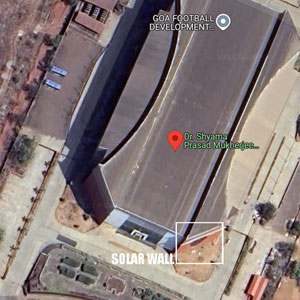
The Challenges
There were many challenges to setup the solar modules as follows:
- Time for the installation : The decision to establish the PoC was made in June 2023; however, the final location was confirmed on July 11, 2023. With the installation scheduled to be showcased during the G20 Summit from July 19 to 21, 2023, we had only 8 days to complete the installation.
- Direction of the wall : The site survey was conducted on July 12 and 13, 2023, during which it was discovered that the façade faced southeast, leaning more towards the east, rather than south-facing. This orientation would not provide optimal sun exposure for the solar modules. Nevertheless, this was embraced as a challenge to demonstrate that Seclink Sedi modules could still generate substantial energy even in less-than-ideal conditions. Once the decision was made, the materials were transported from Mumbai to Goa on July 14, 2023.
- Weather Conditions : Unfortunately, the peak monsoon season in Goa brought heavy rainfall, posing another challenge for the installation. The weather prevented any attempts to install the modules, forcing us to wait for two days until the rain subsided. On July 17, 2023, the skies finally cleared, and the installation work began.
- Availability of cranes with long booms : The finalized wall for installation was approximately 17 meters high, requiring a crane of considerable size. The only available crane on-site belonged to the Fire Department, and an additional day was needed to complete the necessary formalities to secure its use. Work finally began on July 18, 2023. However, the crane broke down after installing about 15 panels, prompting a search for a replacement. This search caused a two-day delay, and installation resumed on July 20, 2023.





